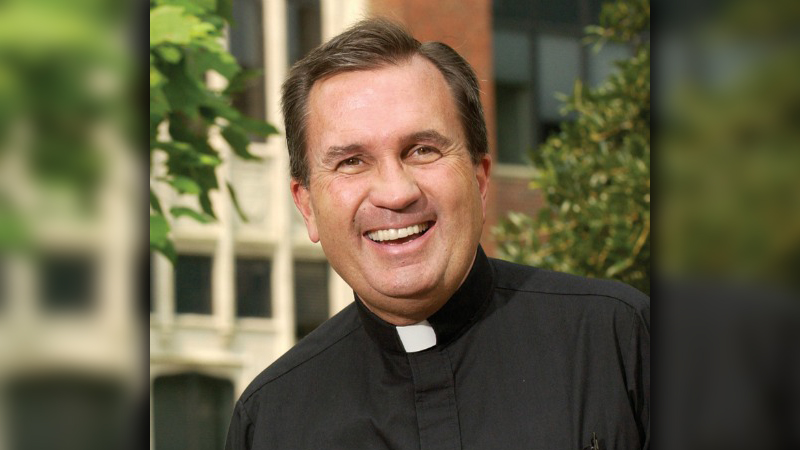NEW ORLEANS -- The Rev. Kevin Wildes, whose decade-plus tenure as president of Loyola University included leading the Uptown school through Hurricane Katrina only to oversee controversial program cuts and combat more recent enrollment and budgetary problems, will retire next year.
The news was first reported by The Loyola Maroon, the campus newspaper.
Wildes said he will retire now that enrollment is up 33 percent and a program designed to put the university on “firm financial footing” by fall 2018 is in place.
“I have always believed that if a university president is going to create a meaningful and lasting legacy, that legacy needs to include leaving the university prepared to do well what it needs to do next,” Wildes wrote in a letter to students, alumni and parents. “It’s an exciting time to be at Loyola University New Orleans – and it is also, for me, the appropriate time to plan to say goodbye.”
Wildes will retire in June 2018, nearly 14 years after he was named president of the Uptown university. A nationwide search for a new president will soon begin, according to an email from Paul Pastorek, chairman of the board of trustees, obtained by WWL-TV.
“With the length of leadership averaging four years, he has more than tripled that average, and Loyola has benefitted from his steady hand of leadership over the challenges faced during his tenure,” Pastorek wrote.
Pastorek thanked Wildes for his leadership during and after Hurricane Katrina, as well as his work in overseeing several renovations on campus and a capital campaign. But as recently as January 2016, faculty who were part of the University Senate voted “no confidence” in him as Loyola weathered a budget and enrollment crisis. The vote was 38-10.
“If this was a company or business, or any other school, someone would’ve gotten fired by now,” The Maroon quoted one professor as saying.
'AMAZED AT HIS ENERGY'
Wildes, who was an associate dean and associate professor of philosophy at Georgetown University before his selection as Loyola’s president, took charge at the campus at a time of upheaval. He replaced a controversial interim president who was brought in after the former president, the Rev. Bernard Knoth, promptly resigned and left New Orleans when allegations of sexual misconduct arose against him.
Wildes, then a candidate for president and former Loyola board member, told students during a March 2004 campus visit that he saw Loyola as a “a great place that wants to be even greater.”
He arrived at Loyola in late July 2003 on a unanimous vote from the Board of Trustees and was installed as president three months later, telling the crowd at his inauguration that he saw the university's role as one of helping to solve the region’s problems.
Wildes quickly developed a reputation as a visible and accessible presence on campus -- and digitally since he was never without his Blackberry and would promptly respond to emails.
Just months after Wildes’ arrival, then-University Senate Chairwoman Nancy Dupont told The Maroon she thought he had already been effective during his time.
“I’ve been amazed at his energy,” Dupont said. “And his ability to juggle so many balls in the air at one time.”
But that view began to change after Katrina.
KATRINA LEADS TO CONTROVERSIAL CUTS
Wildes rode out the storm on campus, which suffered wind damage but largely escaped flooding, but in the subsequent days realized it was time to head to a safer location to draw up a plan for the uncertain future. He moved the university’s operations to Alexandria.
“I thought it was important to maintain offices in Louisiana,” the told The Wolf, Loyola’s yearbook, in spring 2006. “I didn’t want to move everything to Houston.”
By April 2006, the future was the “Pathways Plan,” a series of controversial cuts, including the popular broadcast journalism program and others, like computer science, that were curious to some given that the digital age was just taking hold. Lawsuits from some tenured faculty members followed after they were let go following the loss of their programs.
“The university is facing a great instability in terms of enrollment,” Wildes told a tense meeting of hundreds of agitated and scared students, faculty and staff in announcing the cuts. “We cannot afford the current framework of the institution.”
He told the crowd that about 550 students were expected to enroll that fall. A typical freshman class, he said, was 850 students.
In fall 2006, Wildes drew the ire of faculty when he sent an email instead of holding an annual state-of-the-university address in the wake of the Pathways plan.
POISED FOR GROWTH
Loyola has struggled to grow the student body, and the financial situation has been rough. Faculty have undergone rounds of buyouts in recent years, and last month 27 staff members lost their jobs, while 12 faculty members accepted buyouts. Another 21 positions would not be filled.
In 2013, 200 fewer students than expected enrolled, eventually creating a budget gap of $25 million. A $5 million hole remains unfilled.
But for all the issues in the past, the board and Wildes said the university is poised for growth and stability. Some new programs have been introduced -- including computer science, which was cut after Katrina -- while a record-setting capital campaign has shored up revenues and new scholarship programs have been created.
A Loyola spokeswoman said the university now has 2,553 undergraduate students and 891 graduate students. About 800 first-year students are expected for the fall 2017 semester.
“I am proud of all that we have achieved together and pleased that rewards we are reaping now position us well for the future,” Wildes wrote in the letter announcing his retirement. “While I will be sad to leave Loyola and this exceptional community, I am above all excited for our students and for the future of the university.”


